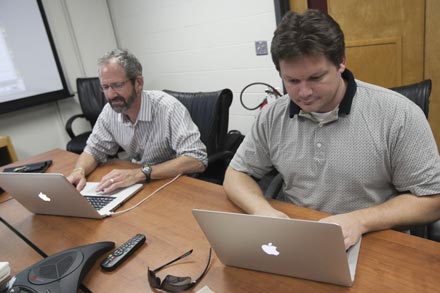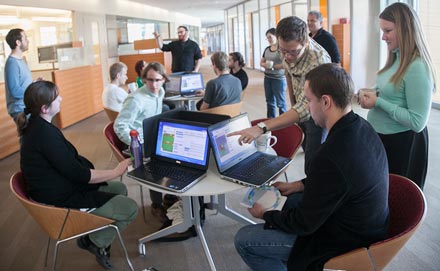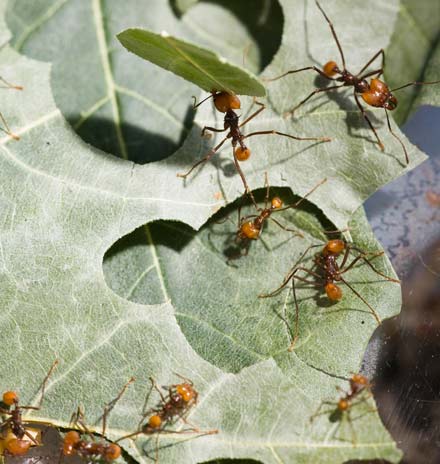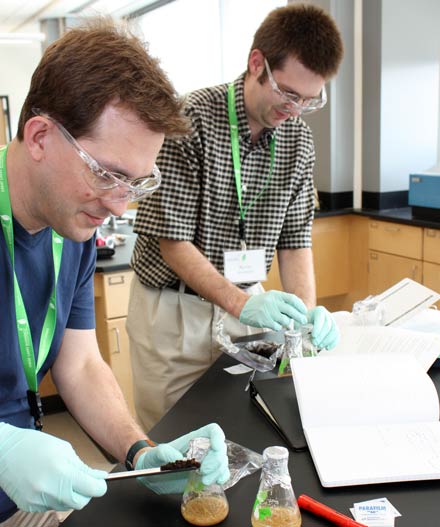Our Education and Outreach team has had a busy year. Read about what the GLBRC is doing to bring cutting-edge bioenergy research to teachers, students, and the public.
The GLBRC Communications team explored new outreach territory in September by hosting a DOE LabChat on Twitter. Featuring GLBRC Conversion Area researcher Brian Pfleger and moderated by Education and Outreach Director John Greenler, the LabChat invited questions from the Twitterverse on the theme, “Biofuels of the Future.”
Pfleger and Greenler’s expertise met a lively and engaged Twitter audience, who provided a steady stream of questions and comments. Topics of discussion included the science, social impacts, and policy behind biofuels research, with a focus on Pfleger’s specialties of synthetic biology and metabolic engineering. View a Storify recap of the chat.

Greenler (left) and Pfleger during GLBRC’s LabChat.
GLBRC’s Education and Outreach team is turning to technology to make learning about bioenergy more interactive. Over the last year, E&O staff members have been working with Wisconsin Institutes for Discovery (WID) faculty to develop a multi-player computer game that simulates the bioenergy crop production cycle, complete with market pressures and sustainability factors. Players take on the role of a farmer and decide which biofuel feedstocks to plant and sell, with an index of environmental, social, and financial success indicating their scores.
The game, which grew out of UW-Madison Computer Science course CS 699, has been developed in collaboration with students and education experts and is now being demonstrated to test audiences.
Leith Nye, GLBRC’s education and outreach specialist, believes that the game has educational benefits that could facilitate the development of new skills and the creation of new knowledge. “Games can engage students in exploration and education outside the classroom,” says Nye.
Future goals for the software-based simulation include a web version and potential social media applications to provide opportunities to communicate and learn about energy.
“Our hope is that people playing the game with this information about economics and sustainability will have to figure out: are there ways to do well at both?” says Ben Shapiro, a scientist in the WID Educational Research group and an instructor for CS 699. “It’s hard to have conversations about these ideas in the abstract, but a game can elicit a lot of discussion.”

Researchers test out the new biofuels farming computer game at the Wisconsin Institutes for Discovery on the University of Wisconsin-Madison campus. Photo by Celia Luterbacher, GLBRC.
Over the last year, the Education and Outreach team has been following the work of Waterford, Wisc. high school teacher Craig Kohn, an alumnus of GLBRC’s Research Experience for Teachers and Bioenergy Institute for Educators. Kohn has taken his experience shadowing GLBRC researchers in the lab and added his own educational expertise to create a hands-on laboratory activity for his students.
The activity involves ‘bioprospecting,’ or searching for biologically significant organisms. Kohn’s approach takes students into their own backyards and gardens to search for and identify microbes that secrete cellulose-degrading enzymes, which could be useful in breaking down biomass for fuel. Kohn has been working with E&O staff to catalog his activity and make it available via the GLBRC website. Watch a slideshow about the bioprospecting activity.

Leaf-cutter ants (Atta cephalotes) are one of the first species GLBRC has targeted for bioprospecting. In Cameron Currie’s UW–Madison lab, researchers study the cellulose-degrading properties of a fungus that grows on the ants’ leaf cuttings. Photo by B.W. Hoffmann.
The GLBRC Education and Outreach team has produced a report designed to support K-12 teachers in their adoption of the soon-to-be-released Next Generation Science Standards (NGSS). The new standards are outlined in the National Resource Council’s (NRC) 2012 Framework for K-12 Science Education.
Based on the Framework’s three key dimensions for engaging students—(1) scientific and engineering practices, (2) crosscutting concepts, and (3) disciplinary core ideas—the E&O report highlights specific GLBRC classroom activity packages and professional development programs that can help educators address the coming changes to science education and evaluation. The E&O team’s goal is to support the nation’s teachers by providing them with resources that exemplify the more rigorous and varied scientific experiences envisioned in the NRC Framework. View the report on the E&O webpage.

GLBRC resources like the E&O report and the annual Bioenergy Institute for Educators program (pictured above) are designed to help K-12 teachers foster excellence and engagement in science education. Photo by John Greenler, GLBRC.